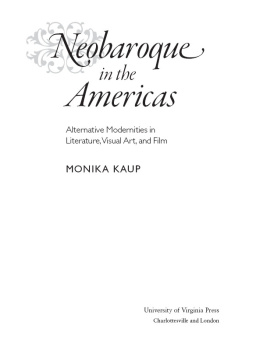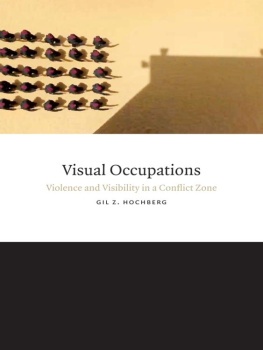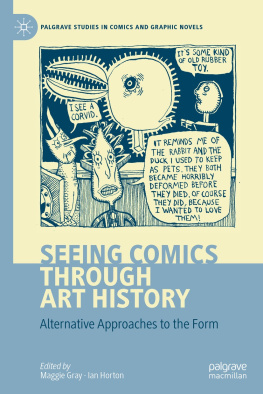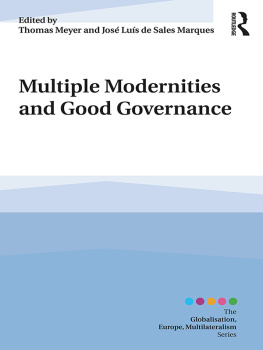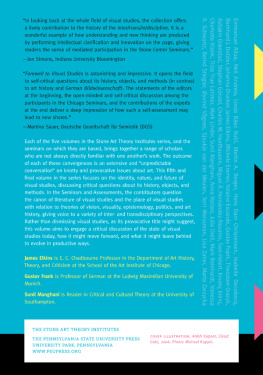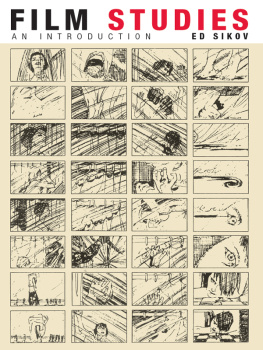
Neobaroque in the Americas
NEW WORLD STUDIES
J. Michael Dash, Editor
Frank Moya Pons and
Sandra Pouchet Paquet,
Associate Editors

University of Virginia Press
2012 by the Rector and Visitors of the University of Virginia
All rights reserved
Printed in the United States of America on acid-free paper
First published 2012
9 8 7 6 5 4 3 2 1
Library of Congress Cataloging-in-Publication Data
Kaup, Monika.
Neobaroque in the Americas : alternative modernities in literature, visual art, and film / Monika Kaup.
p. cm. (New world studies)
Includes bibliographical references and index.
ISBN 978-0-8139-3313-9 (pbk. : alk. paper) ISBN 978-0-8139-3312-2 (cloth : alk. paper) ISBN 978-0-8139-3314-6 (e-book)
1. Latin AmericaCivilization21st century. 2. United StatesCivilization21st century. 3. Baroque literatureInfluence. 4. Art, BaroqueInfluence. I. Title.
F1408.3K385 2012
980.04dc23
2012019470
For my parents
CONTENTS
ILLUSTRATIONS
ACKNOWLEDGMENTS
OVER THE YEARS that went into the making of this book, large debts of gratitude have accumulated to many colleagues and friends who offered advice and encouragement at various stages.
I would like to acknowledge and thank Eric Ames, Herb Blau, Marshall Brown, Laura Chrisman, Ruth Little, Christopher Johnson, Adrian Martin, Geoffrey McCafferty, Brian Reed, Jacobo Sefam, and James Tweedie. I am indebted to Patrick Blaine, Eric Ames, and the staff at the University of Washingtons Center for Digital Arts and Experimental Media for technical assistance in acquiring screen captures. Mary Brisson of the Peterson Automotive Museum offered generous help. Special thanks are due to Lois Parkinson Zamora, who provided crucial encouragement and instruction at the beginning of my engagement with the myriad forms of the Baroque. In addition, I would like to extend warm thanks to the Neobarockers of the Hispanic Baroque research project, funded by the Social Sciences and Humanities Research Council of Canada, for providing me with a sounding board for my ideas as my work progressed. At the University of Virginia Press, I am grateful to my editor Cathie Brettschreider, to my in-house editor Morgan Myers, and to the two anonymous readers who offered helpful comments. Finally, throughout I have been fortunate to count on the companionship of Robert Mugerauer for insights, inspiration, and boundless support.
There are also institutions to thank: a grant from the Royalty Research Fund at the University of Washington supported initial research for this project, and a sabbatical leave allowed me to complete the manuscript. My college and department at the University of Washington provided financial support for production costs, and Modern Language Quarterly contributed support for conference travel related to this project.
Finally, I would like to thank the publishers of journals in which earlier versions of certain chapters appeared:
The introduction includes revised versions of material originally published in Neobaroque: Latin Americas Alternative Modernity, Comparative Literature 58, no. 2 (Spring 2006), and The Future Is Entirely Fabulous: The Baroque Genealogy of Latin Americas Modernity, Modern Language Quarterly 68, no. 2 (June 2007).
, on Djuna Barnes, is a revised and significantly expanded version of The Neobaroque in Djuna Barnes, published in Modernism/Modernity 12, no. 1 (2005).
The section in on Jos Donoso is a revised version of Postdictatorship Allegory and Neobaroque Disillusionment in Jos Donosos Casa de campo,Chasqui 34, no. 2 (November 2005).
incorporates revised portions of Becoming-Baroque: Folding European Forms into the New World Baroque with Alejo Carpentier, CR: The New Centennial Review 5, no. 2 (2005).
Neobaroque in the Americas
Introduction
Neobaroque Alternative Modernities
THIS BOOK opens with a portrait of neobaroque T. S. Eliot and closes with contemporary baroques in Chicano lowrider art and the hip-hop baroque in Cuban American art. In between, it ranges over vastly diverse territory: the major works of Djuna Barnes, contemporary antidictatorship literature and film from Chile and Argentina by Diamela Eltit, Jos Donoso, Ral Ruiz, and Mara Luisa Bemberg, and Latin American and Caribbean postcolonial theory outlining the emergence of a decolonizing New World baroque in the seventeenth and eighteenth centuries. It encompasses Spanish-language and English-language works, focusing mainly on the United States and the Southern Cone (the region of Latin America comprising Argentina, Chile, Paraguay, Uruguay, and Southern Brazil), and juxtaposes long-neglected Anglo-American neobaroque expression with the more familiar (or at least more predictable) Latin American and Latino varieties. Neobaroque in the Americas is an interartistic study that spans literature, film, architecture, and the visual arts and also incorporates the twentieth-century philosophy and cultural theory of Walter Benjamin, Gilles Deleuze, Michel Foucault, Irlemar Chiampi, Bolvar Echeverra, and Christine Buci-Glucksmann. Few literary and cultural phenomena allow the researcher to roam this far in pursuit of her topic, looking both high and low in the arts, ranging from modernist experimentalism (Eliot and Barnes) to postmodern and contemporary developments such as post-Boom antidictatorship literature and film from the Southern Cone; traveling north and south across the American hemisphere; tracing parallel but distinct European and American mestizo genealogies of the same artistic expression (the European baroque and the transculturated mestizo New World baroque); and consequently being forced to make difficult choices along the way in balancing equally compelling word-based and image-based varieties.
The baroque is an exceptional and fascinating phenomenon, in no small part because of the prolific afterlife it has had in generating new baroques, both in the seventeenth and eighteenth centuries and again in the twentieth But even though the baroque began as a conservative style, in the official arts sponsored by the Catholic Church and the absolutist state, many of the new baroques that arose subsequently deviated diametrically from these social origins. The wayward, rich afterlife of the historical baroque has vastly expanded baroque expression along two paradigmatic coordinates, time and spaceor history, as found in the twentieth- and twenty-first-century neobaroque, and geographic and cultural location, as found in the seventeenth- and eighteenth-century New World baroque, which has continuities with contemporary postcolonial and ethnic neobaroques.
Like the baroque before it, the neobaroque spread in nonlinear fashion across multiple boundaries among languages, nations (and continents), ethnic groups, and disciplines. Reflecting this rich transhistorical and transcultural genealogy of expression, the baroque today is one of the poster children of interdisciplinary arts and culture. The comparative nature of this study is perfectly suited to its subject: no narrow, disciplinarynation-based, genre-based, ethnocentric or otherwise noncomparativeinquiry can ever hope to capture the uniqueness and complexity of the baroque. Neobaroque in the Americas examines the neobaroquethe twentieth- and twenty-first-century recovery of the baroque in modern and postmodern literature, film, the visual arts, and theorywithin a hemispheric American framework. As such, it is broadly aligned with Roland Greenes suggestion that the neobaroque in spirit is a decisively American phenomenon, probably because this hemisphere provides a distance and delay from the original baroque that allows it to be critically refashioned.
Next page
